Your chickens will need properly formulated chicken feed that is the correct type for their age, for growth, sustenance and to produce eggs if they are hens of egg laying age. There are many old wives tales and alternative views on feeding, some say it’s marketing that has created all of these feeds and hens will survive well on wheat and others will say their grandad never had layers pellets and just fed his hens kitchen scraps! Formulated poultry feeds didn’t exist until recently, primarily created thanks to commercial research on hens diets as we tried to squeeze more and more eggs out of hens.
In days gone by though when ‘grandad fed scraps’, pure breeds were kept for eggs and they were fed grain mixes or dried mash chicken feed that had meat or fish meal added to increase the protein content. Hens would free range over a large area and could also supplement their diet with what they could forage. Bugs, insects and worms are all valuable sources of protein, not forgetting a good selection of greens providing vitamins and minerals.
“Grandad’s chickens didn’t get chicken feed and survived on kitchen scraps but they could free range to top up their diet on protein, vitamins, minerals and calcium from the fields or orchards they grazed. They didn’t produce anything like the number of eggs modern hybrid hens or some pure breeds produce.”
So in short, if you don’t feed a proper formulated layers feed to your hens, they won’t be able to keep up the demands that egg-laying puts on their bodies.
Layers Feeds and Protein
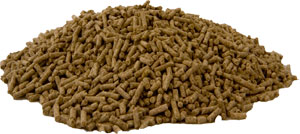 Chickens require protein to produce feathers and eggs as well as to grow. The amount of protein in their diet is important and you will see on the ingredients on the back of bags of commercial feeds the percentage of protein that they contain. It is higher in ‘Growers Pellets’ for example to enable chickens to grow and produce feathers. You will find that chickens stop laying eggs when they moult (lose their feathers and regrow new) as they are diverting protein from egg production to feather production. During the moult, you can scatter a handful of cat kibble in the run which helps them to top up with protein. Do not use dog food as most of the protein is derived from cereals.
Chickens require protein to produce feathers and eggs as well as to grow. The amount of protein in their diet is important and you will see on the ingredients on the back of bags of commercial feeds the percentage of protein that they contain. It is higher in ‘Growers Pellets’ for example to enable chickens to grow and produce feathers. You will find that chickens stop laying eggs when they moult (lose their feathers and regrow new) as they are diverting protein from egg production to feather production. During the moult, you can scatter a handful of cat kibble in the run which helps them to top up with protein. Do not use dog food as most of the protein is derived from cereals.
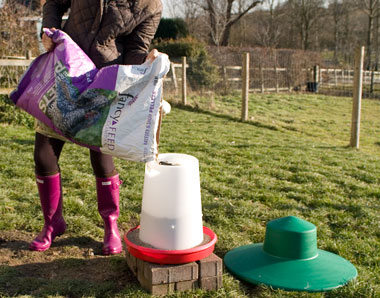
Commercial feeds contain the right balance of nutrients & can be fed ad-lib in hoppers if kept dry. This one has a rain hat.
Commercial chicken feeds have been well researched and contain the correct balance of minerals and nutriets required by chickens as well as sufficient protein and calcium which is essential for egg shell production. Layers pellets for example are around 16% protein. Wheat is about 10% protein and lacks essential vitamins that are required by chickens.
Formulated feeds come as pellets or mash and should be fed ad-lib so hens can take what they want as they need it. This type of feed must be kept dry or it will soon spoil. The feeder and rain hat shown above is the only sort I have found that really does keep the feed dry. Most have a hole in the top of the hat for a handle or for hanging and this lets water in. A feeder and rain hat similar to this one can be bought from Omlet.
Eggs are made up of around 80% protein so if there’s a shortage of protein in their diet, egg laying will be the first thing they your girls cut back on!
There is more information on the poultykeeper.com site which has a very good page of feeding chickens and chicken feed.
Mixed corn
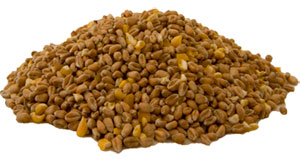 Mixed corn is usually 80 to 90% wheat and 10 to 20% maize. It is useful as a scratch feed, it keeps hens active, scratching around looking for it but should only be considered a treat. A handful per hen thrown late afternoon helps them to have a full crop overnight.
Mixed corn is usually 80 to 90% wheat and 10 to 20% maize. It is useful as a scratch feed, it keeps hens active, scratching around looking for it but should only be considered a treat. A handful per hen thrown late afternoon helps them to have a full crop overnight.
The maize (yellow in colour) is very fattening but can be useful during very cold weather to help your hens keep warm – I increase my girls’ ration of corn when it is cold over the winter, after they have finished moulting (they need lots of protein during the moult) since they are not laying eggs and need a little extra fat to burn in order to keep warm.
If you feed too much corn, your hens will get fat and fat hens don’t lay eggs!
Household scraps
Feeding household scraps is no longer allowed according toi DEFRA and can be a bit hit and miss anyway. You don’t really know what a hen is getting and the diet is very unbalanced. It is for this reason that scraps used to be mixed into a mash by using layers mash and water (which can be warm in winter). The mixture should be a sort of crumbly mix, not too wet but not too dry. Feeding scraps should be limited to at most 25% of a hens diet so as not to tip the balance too far one way or another.
Greens
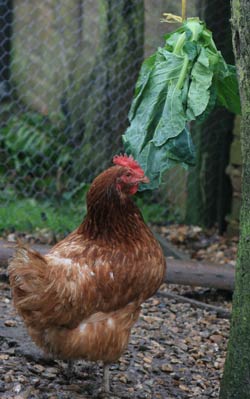 Ample green stuff should be provided for your hens. Grass cuttings, weeds and off-cuts from cabbages, cauliflowers and other greens can be provided at minimal cost. Lettuce should be fed in moderation because it has very little nutritional value (very little Protein and Energy / Calories) and avocado pear is poisonous to hens but most other greens that come from the kitchen will be appreciated by your girls. Try hanging greens in their run, just a little higher than they can reach. As they eat them, they will need to jump to get the last bits so will be getting exercise at the same time as their greens! Win-win!
Ample green stuff should be provided for your hens. Grass cuttings, weeds and off-cuts from cabbages, cauliflowers and other greens can be provided at minimal cost. Lettuce should be fed in moderation because it has very little nutritional value (very little Protein and Energy / Calories) and avocado pear is poisonous to hens but most other greens that come from the kitchen will be appreciated by your girls. Try hanging greens in their run, just a little higher than they can reach. As they eat them, they will need to jump to get the last bits so will be getting exercise at the same time as their greens! Win-win!
If you have an area in which you can grow cabbages in your garden, it may be worthwhile thinking about growing a row for the winter. Cabbages will sit there in the cold, perfectly preserved until picked. You will need to keep them covered with fleece when there are cabbage white butterflies around but don’t worry if they are a little eaten, the chooks won’t mind!
Mealworm treats
Many chicken keepers like to buy mealworms or chicken treats containing these. Chickens love these and are easily tamed by using such tasty treats, however you should keep in mind that animal by-product regulations mean that mealworms are not really allowed to be fed to poultry.


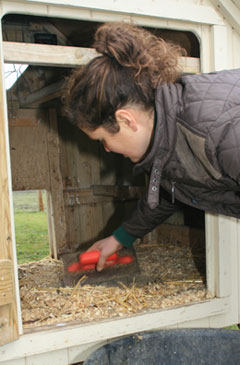

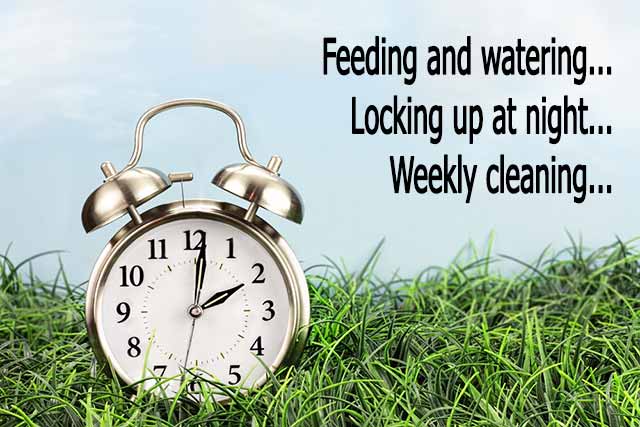
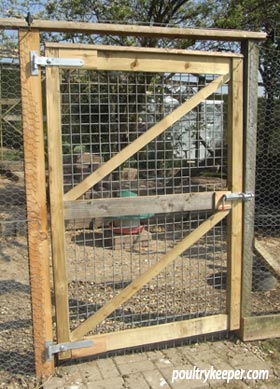
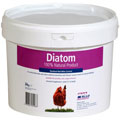
A wee help. Hens will not eat fir needles. Most firs produce phenols which are toxic(the smell in pine and cedar) Rowan berries should be fine, most birds can break down the cyanide in these berries. Again the bird knows best. As for Ivy, should you want rid then spray with glyphosate. Well before the hens appear as this weedkiller can cause problems with ovulation if ingested by poultry. If on the ground it can create a significant tripping hazard for hens, but that said it is also a great place for insects to thrive which the hens love to chase, so best maintained to edging. If like me you have a large area for your hens. (In my case 12 hens, 14 muscovy ducks in 1.2 acres) As they grow do not feed them every day, maybe miss a day or two per week as this will encourage them to forage. Best time NOT to feed is after rain. When cutting grass do not remove the clippings as this allows the bugs to move in and the hens love scratching it up and it helps keep moisture close to the ground for insects to live. It is also good for soil more so if you can move the hens to another area after a couple of years, turn it over and use as a vegetable patch…. Do not forget hen droppings are one of the best fertilisers, compost and use elsewhere….
Great page, keep up the good work 😉
Hi there,
your site is very much appreciated, unbelievably helpful, thank you
My question being, i have no grass i recently got 5 girls, they are not interested in the greens im putting in the run and not too interested in the mealworms either, i dug up a few worms, they loved them, im going to try raisins and peanuts next as treats, but the main question is i have very little grass, i cut it the other day and gave my girls the cuttings, they ate the lot, please can i ask your opinion on buying a turf of grass from b&q, at the moment sitting at £1.50 per length, do you think it would be ok to buy some of these for my girls to eat and roll them out within the run , your thoughts would be much appreciated
Kind regards
Rab
See my comments to your other question about turf. I would guess they are being fussy because they are full up and have too many treats 😉 Hungry chickens will love such treats.
Sorry, I have very little grass, not enough to brag about, your thoughts on the B&Q turf would be so much appreciated.
I would leave this alone – it probably has chemicals on it. It won’t last long either. Better is to provide a deep bed of hardwood chippings for them to scratch through and then feed lots of greens – weeds will do but you can hang greens / cabbages etc and sweetcorn for a treat in the run. Hang them a little too high for them to reach and then they will get exercise jumping up.
At what age can I feed my chicks chicken feed instead of chick crumbs… Their 8 weeks old are they going to be able to eat chicken feed thanks
You need to change their diet to Growers Pellets now and then on to layers at POL around 18-20 weeks of age when they are fully grown.
Hi, can one mix chicken breeds or is it safer to stick to just one? thanks.
If they are similar in size and have enough space, you can usually get away with it but it will depend a little on their temperament.